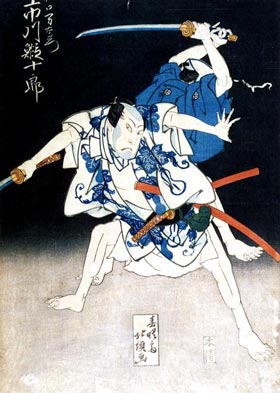| ICHIKAWA EBIJ█Rď II |
|
Stage names:
Guild: Harimaya Line number: NIDAIME (II) Poetry names: Shinsh˘ Existence: 1806 ~ 24th day of the 11th lunar month of 1829 [1] Connection: Father: Ichikawa Ebijűr˘ I Career: 1806: born in ďsaka. 11th lunar month of 1815: he received the name of Ichikawa Sukez˘ I. 11th lunar month of 1817: Ichikawa Sukez˘ I took the name of Ichikawa Ichiz˘ II in ďsaka. 1st lunar month of 1820: Ichiz˘ and his father Ichikawa Ebijűr˘ I went together to Edo; Ichiz˘ became tachiyaku and performed at the Kawarasakiza in the new year program "Tama no Haru Soga no Kadomatsu". Fall 1821: Ichiz˘ and his father Ichikawa Ebijűr˘ I went back to ďsaka. 16th day of the 7th lunar month of 1827 [2]: his father Ichikawa Ebijűr˘ I died. Fall 1827: Ichiz˘ went to Edo with Band˘ Minosuke II. 11th lunar month of 1827: Ichiz˘ played at the Ichimuraza the roles of Okabe no Yatar˘ and the hairdresser Goichibŕ in the kaomise drama "Kawaranu Hana Genji no Kaomise". Fall 1828: Ichiz˘ went back to Kamigata. 11th lunar month of 1828: Ichikawa Ichiz˘ II took the name of Ichikawa Ebijűr˘ II in Ky˘to at the Kitagawa no Shibai, performing in the kaomise drama "Asoyama Zakura"; his stage partners were Nakamura Utaemon III, Ichikawa Danz˘ V, Ogawa Kichitar˘ III, Nakamura Matsue III, Sawamura Kunitar˘ II, Arashi Rik˘ I, Asao Gakujűr˘, Nakayama Bunshichi III and Nakayama Shinkur˘ IV. 12th lunar month of 1828: Ebijűr˘ played at the Takeda no Shibai the roles of Gengobŕ, Kataoka Hachir˘ and Kamura Utaemon in the dramas "Suda no Haru Geisha Katagi", "Gosho Zakura Horikawa no Youchi" and "Hinin no Adauchi". 1st lunar month of 1829: Ebijűr˘'s rank in the Kamigata hy˘banki, jitsuaku/katakiyaku section, was j˘-j˘-(shiro)kichi (superior - superior - (white) excellent) [visual]. He was the kanjiku for this category of actors. 7th lunar month of 1829: Ebijűr˘ appeared on stage for the last time, in ďsaka at the Kado no Shibai, where he played the role of Daishichi in the drama "Go Taiheiki Shiraishi Banashi". He also played the roles of Horiguchi Man'emon and Ude no Jihŕ in the drama "Kizugawa no Hakkei". He suddenly fell ill and had to retire. 24th day of the 11th lunar month of 1829 [1]: Ebijűr˘ died in ďsaka [3]. Comments: Ichikawa Ebijűr˘ II was a promising ďsaka actor, who followed in the footsteps of his father as a tachiyaku or jitsuaku actor. He unfortunately died too young. [1] The 24th day of the 11th lunar month of the 12th year of the Bunsei era was the 19th of December 1829 in the western calendar. [2] The 16th day of the 7th lunar month of the 10th year of the Bunsei era was the 6th of September 1827 in the western calendar. [3] His tombstone was located in the precincts of the Daifukuin sub-temple of the Mitsudera temple (ďsaka). |
 |
|
Ichikawa Ebijűr˘ II playing the role of Horiguchi Man'emon in the drama "Sao no Uta Kizugawa Hakkei", which was staged in the 7th lunar month of 1829 in ďsaka at the Kado no Shibai (print made by Shunshosai Hokuch˘) Print made by Shunk˘sai Hokushű in 1827 Print made by Shumbaisai Hokuei in 1829 Print made by Utagawa Kunihiro in 1829 Print made by Shunshosai Hokuch˘ in 1829 The Ichikawa Sukez˘ line of actors The Ichikawa Ichiz˘ line of actors The Ichikawa Ebijűr˘ line of actors |
|
|
| Contact | Main | Top | Updates | Actors | Plays | Playwrights | Programs | Links | FAQ | Glossary | Chronology | Illustrations | Prints | Characters | Derivatives | Theaters | Coming soon | News |